Multi-Level Participatory GIS Framework to Assess Mobility Needs and Transport Barriers in Rural Areas: A Case Study of Rural Mumias East, a Sub-County of Kakamega, Kenya
Abstract
1. Introduction
1.1. Knowledge Gaps in Rural Mobility
1.2. The Study Area
- (i)
- Lusheya location (Lusheya sub-location); population: 37,609; sq km: 57; Lusheya-Lubinu ward, Mumias East sub-counties; latitude: 0.3199904; longitude: 34.543329.
- (ii)
- Khaunga location (Khaunga and Mahola sub-locations); population: 32,343; sq km: 35.10; East-Wanga ward, Mumias East sub-counties; latitude: 0.3764; longitude: 34.5779.
2. Literature Review
2.1. Overview of GIS and PGIS Research Streams
- (i)
- The software component brings geographic data into the GIS—either from remote sensing sources, ordinary printed or digital maps, or field reports—and converts this data into a computer-readable form.
- (ii)
- The database incorporated by a GIS allows the data to be managed and deployed.
2.2. ML-PGIS Frameworks Review for Transport Planning/Mobility Need Assessment/Mobility Analysis
- Social Shaping of Technology: In the first theory, the attention is paid to the diversity of actors’ interpretations of meaning and content of technology [31].
- Contextualism approach: This approach introduced by Pettigrew [34] argues for the lack of process and context in research aimed at institutional change and therefore emphasizes the need for three-dimensional research that includes context, process and content. These dimensions are integrated by Pozzebon and Diniz [30] into four main concepts: (i) relevant social groups, (ii) interpretive frames, (iii) negotiation and (iv) technology in practice.
3. Materials and Methods
3.1. Data Collection
3.1.1. Standard Data Listing (L1)
3.1.2. Secondary Data Collection
3.1.3. Training and Primary Data Collection
- a.
- Data Gap Analysis
- b.
- Orientation Session and Technical Training
- c.
- Data Collection Exercise
3.1.4. Data Validation
3.1.5. Data Analysis
- a.
- Cleaning of data layers collected from various sources
- b.
- Daily “Males vs. Females” Analysis
- c.
- Analysis of mobility needs
4. Findings
4.1. Level 1—The Context of the Mumias East Project: Institutional and Interactional
4.2. Level 2—The Process of Implementing a PGIS Framework
Stakeholders’ Interactions and Data Management and Capture
4.3. Level 3—The Content in the Implementation of a PGIS
4.3.1. Data Validation
4.3.2. Evaluation of the Mobility Impacts
5. Discussion and Conclusions
5.1. Context in the PGIS Framework
5.2. Process in the PGIS Framework
5.3. Content in the PGIS Framework
5.4. Conclusions
Supplementary Materials
Author Contributions
Funding
Institutional Review Board Statement
Informed Consent Statement
Data Availability Statement
Acknowledgments
Conflicts of Interest
References
- World Bank. Sustainable Mobility for All. Global Roadmap of Action toward Sustainable Mobility: Universal Rural Access; World Bank: Washington, DC, USA, 2019. [Google Scholar]
- Dennis, R. Transport and accessibility. In A Synthesis Paper, Employment Intensive Investment Branch; International Labour Office: Geneva, Switzerland, 1998. [Google Scholar]
- Barwell, I.J. Transport and the Village: Findings from African Village-Level Travel and Transport Surveys and Related Studies (English); World Bank Discussion Papers; No. WDP 344. Africa Region Series; World Bank: Washington, DC, USA, 1996; Available online: http://documents.worldbank.org/curated/en/846361468764127131/Transport-and-the-village-findings-from-African-village-level-travel-and-transport-surveys-and-related-studies (accessed on 20 April 2023).
- Ahern, A.; Hine, J. Rural transport—Valuing the mobility of older people. Res. Transp. Econ. 2012, 34, 27–34. [Google Scholar] [CrossRef]
- Wahba Tadros, S.N.; Wellenstein, A.; Das, M.B.; Palmarini, N.; D’Aoust, O.S.; Singh, G.; Restrepo Cadavid, P.; Goga, S.; Terraza, H.C.; Lakovits, C.; et al. Demographic Trends and Urbanization (English). World Bank Group: Washington, DC, USA. Available online: http://documents.worldbank.org/curated/en/260581617988607640/Demographic-Trends-and-Urbanization (accessed on 29 September 2022).
- Dasgupta, P.; Morton, J.F.; Dodman, D.; Karapinar, B.; Meza, F.; Rivera-Ferre, M.G.; Toure Sarr, A.; Vincent, K.E. Rural Areas. In Climate Change 2014: Impacts, Adaptation, and Vulnerability. Part A: Global and Sectoral Aspects. Contribution of Working Group II to the Fifth Assessment Report of the Intergovernmental Panel on Climate Change; Field, C.B., Barros, V.R., Dokken, D.J., Mach, K.J., Mastrandrea, M.D., Bilir, T.E., Chatterjee, M., Ebi, K.L., Estrada, Y.O., Genova, R.C., et al., Eds.; Cambridge Unviersity Press: Cambridge, UK; New York, NY, USA, 2014; pp. 613–657. [Google Scholar]
- Strohmeier, F. Barriers and their influence on the mobility behavior of elder pedestrians in urban areas: Challenges and best practice for walkability in the city of Vienna. Transp. Res. Procedia 2016, 14, 1134–1143. [Google Scholar] [CrossRef]
- Giuffrida, N.; Le Pira, M.; Inturri, G.; Ignaccolo, M. Mapping with Stakeholders: An Overview of Public Participatory GIS and VGI in Transport Decision-Making. ISPRS Int. J. Geo-Inf. 2019, 8, 198. [Google Scholar] [CrossRef]
- Sieber, R.E.; Pamela, J.; Robinson, P.J.; Peter, A.; Johnson, P.A.; Jon, M.; Corbett, J.M. Doing Public Participation on the Geospatial Web. Ann. Am. Assoc. Geogr. 2016, 106, 1030–1046. [Google Scholar] [CrossRef]
- Verplanke, J.; McCall, M.K.; Uberhuaga, C.; Rambaldi, G.; Haklay, M. A Shared Perspective for PGIS and VGI. Cartogr. J. 2016, 53, 308–317. [Google Scholar] [CrossRef]
- Pozzebon, M.; Rozas, S.T.; Delgado, N.A. Use and Consequences of Participatory GIS in a Mexican Municipality: Applying a Multilevel Framework; Revista de Administracao de Empresas: São Paulo, Brazil, 2015; Volume 55, pp. 290–303. [Google Scholar]
- Minang, P.A.; Mccall, M.K. Participatory GIS and local knowledge enhancement for community carbon forestry planning: An example from Cameroon. Particip. Learn. Action 2006, 54, 11. [Google Scholar]
- Brown, G.; Kyttä, M. Key issues and research priorities for public participation GIS (PPGIS): A synthesis based on empirical research. Appl. Geogr. 2014, 46, 122–136. [Google Scholar] [CrossRef]
- National Land Value Index. County Government of Kakamega. In County Annual Development Plan F/Y 2019/20; Ministry of Lands and Physical Planning: Kakamega, Kenya, 2020. [Google Scholar]
- Puri, S.K. Integrating scientific with indigenous knowledge: Constructing knowledge alliances for land management in India. MIS Q. 2007, 31, 355–379. [Google Scholar] [CrossRef]
- Rambaldi, G.; Kwaku Kyem, A.P.; Mbile, P.; McCall, M.; Weiner, D. Participatory spatial information management and communication in developing countries. Electron. J. Inf. Syst. Dev. Ctries. 2006, 25, 1–9. [Google Scholar] [CrossRef]
- Mcconchie, J.; McKinnon, J. Using GIS to produce community-based maps to promote collaborative natural resource management. ASEAN Biodivers. 2002, 2, 27–34. [Google Scholar]
- Weingart, P.; Joubert, M.; Connoway, K. Public engagement with science—Origins, motives and impact in academic literature and science policy. PLoS ONE 2021, 16, e0254201. [Google Scholar] [CrossRef]
- Dietz, T.; Stern, P. (Eds.) Public Participation in Environmental Assessment and Decision-Making; National Academies Press: Washington, DC, USA, 2008. [Google Scholar]
- Harris, T.M.; Weiner, D.; Warner, T.; Levin, R. Pursuing social goals through participatory GIS: Redressing South Africa’s historical political ecology. In Ground Truth: The Social Implications of Geographical Information Systems; Pickles, J., Ed.; Guilford: New York, NY, USA, 1995; pp. 196–222. [Google Scholar]
- Weiner, D.; Harris, T.M. Community-integrated GIS for Land Reform in South Africa. URISA J. 1995, 15, 61–73. [Google Scholar]
- Harris, T.; Weiner, D. Empowerment, Marginalization, and “Community-integrated” GIS. Cartogr. Geogr. Inf. Syst. 1998, 25, 67–76. [Google Scholar] [CrossRef]
- Hutchinson, C.F.; Toledano, J. Guidelines for demonstrating geographical information systems based on participatory development. Int. J. Geogr. Inf. Syst. 1993, 7, 453–461. [Google Scholar] [CrossRef]
- Corbett, J.; Keller, C. An analytical framework to examine empowerment associated with Participatory Geographic Information Systems (PGIS). Cartographica 2005, 40, 91–102. [Google Scholar] [CrossRef]
- Sieber, R. Public participation geographic information systems: A literature review and framework. Ann. Assoc. Am. Geogr. 2006, 96, 491–507. [Google Scholar] [CrossRef]
- Pozzebon, M.; Diniz, E.; Jayo, M. Adapting the structurationist view of technology for studies at the community societal levels. In Handbook of Research on Contemporary Theoretical Models in IS; Dwivedi, Y.D., Lal, B., Williams, M., Schneberger, S., Wade, M., Eds.; Information Science Reference: Hershey, PA, USA, 2009; pp. 18–33. [Google Scholar]
- Nair, S.; Kshirsager, M. Multi-Level participatory GIS for natural resource management: A review of contemporary research. J. Environ. Manag. 2017, 192, 163–178. [Google Scholar]
- Budhathoki, N.R.; Haynie, H.J.; Goodchild, M.F. The role of volunteered geographic information in participatory planning: A case study of participaotry GIS in Plano, Texas. URISA J. 2008, 20, 33–44. [Google Scholar]
- Chambers, R. Participatory GIS empowerment: Enabling community-based natural resource management. J. Environ. Manag. 2006, 78, 7–21. [Google Scholar]
- Pozzebon, M.; Diniz, E. Theorizing ICT and society in the Brazilian context: A multilevel, pluralistic and remixable framework. BAR-Braz. Adm. Rev. 2012, 9, 287–307. [Google Scholar] [CrossRef]
- Wilson, M.; Howcroft, D. Power, politics and persuation in IS evaluation: A focus on relevant social groups. J. Strateg. Inf. Syst. 2005, 14, 17–43. [Google Scholar] [CrossRef]
- Giddens, A.; Pierson, C. Conversations with Anthony Giddens; Polity Press: Cambridge, UK, 1989. [Google Scholar]
- Jones, M.R.; Karsten, H. Gidden’s structuration theory and information systems research. MIS Q. 2005, 32, 127–157. [Google Scholar] [CrossRef]
- Pettigrew, A.M. Contextualist research and the study of organizational change processes. In Research Methods in Information Systems; Mumford, E., Hirschheim, R., Fitzgerald, G., Wood-Harper, A., Eds.; North Holland: New York, NY, USA, 1985; pp. 53–72. [Google Scholar]
- De Souza, R.-M.; Clarke, J. Advancing Coastal Climate Resilience: Inclusive Data and Decision-Making for Small Island Communities. In Advancing Coastal Climate Resilience Chapter 11; Adaptation Actions—Hazards, Ecosystems, Sectors, Resilience; Elsevier: Amsterdam, The Netherlands, 2018. [Google Scholar] [CrossRef]
- Zolkafli, A.; Liu, Y.; Brown, G. Bridging the knowledge divide between public and experts using PGIS for land use planning in Malaysia. Appl. Geogr. 2017, 83, 107–117. [Google Scholar] [CrossRef]
- Fagerholm, N.; Torralba, M.; Moreno, G.; Girardello, M.; Herzog, F.; Aviron, S.; Burgess, P.; Crous-Duran, J.; Ferreiro-Domínguez, N.; Graves, A.; et al. Cross-site analysis of perceived ecosystem service benefits in multifunctional landscapes. Glob. Environ. Chang. 2019, 56, 134–147. [Google Scholar] [CrossRef]
- Kyem, P.A. Finding common ground in land use conflicts using PGIS: Lessons from Ghana. Particip. Learn. Action 2006, 54, 36–40. [Google Scholar]
- Kahila-Tani, M.; Kyttä, M.; Nummi, P. Crowdsourcing place-based memories. In Heritage is Ours—Citizens Participating in Decision Making; Halme, A.-M., Ed.; EuropaNostra: Helsinki, Finland, 2018; pp. 128–131. Available online: http://www.europanostra.fi/wp-content/uploads/2018/03/HeritageisOursBook9.3.pdf (accessed on 15 October 2020).
- Ramirez-Gomez, S.O.I.; Brown, G.; Fat, A.T.S. Participatory mapping with indigenous communities for conservation: Challenges and lessons from suriname. Electron. J. Inf. Syst. Dev. Ctries. 2013, 58, 1–22. [Google Scholar] [CrossRef]
- Samuelsson, K.; Giusti, M.; Peterson, G.D.; Legeby, A.; Brandt, S.A.; Barthel, S. Impact of environment on people’s everyday experiences in Stockholm. Landsc. Urban Plan. 2018, 171, 7–17. [Google Scholar] [CrossRef]
- Kajosaari, A.; Hasanzadeh, K.; Kyttä, M. Residential dissonance and walking for transport. J. Transp. Geogr. 2019, 74, 134–144. [Google Scholar] [CrossRef]
- Lechner, A.M.; Raymond, C.M.; Adams, V.M.; Polyakov, M.; Gordon, A.; Rhodes, J.R.; Mills, M.; Stein, A.; Ives, C.D.; Lefroy, E.C. Characterizing spatial uncertainty when integrating social data in conservation planning. Conserv. Biol. 2014, 28, 1497–1511. [Google Scholar] [CrossRef]
- Brown, G.; Kelly, M.; Whitall, D. Which “public”? Sampling effects in public participation GIS (PPGIS) and volunteered geographic information (VGI) systems for public lands management. J. Environ. Plan. Manag. 2014, 57, 190–214. [Google Scholar] [CrossRef]
- Brown, G.; Strickland-Munro, J.; Kobryn, H.; Moore, S.A. Mixed methods participatory GIS: An evaluation of the validity of qualitative and quantitative mapping methods. Appl. Geogr. 2017, 79, 153–166. [Google Scholar] [CrossRef]
- Jankowski, P.; Czepkiewicz, M.; Młodkowski, M.; Zwoliński, Z. Geo-questionnaire: A method and tool for public preference elicitation in land use planning. Trans. GIS 2016, 20, 903–924. [Google Scholar] [CrossRef]
- Rohrbach, B.; Anderson, S.; Laube, P. The effects of sample size on data quality in participatory mapping of past land use. Environ. Plan. B Plan. Des. 2016, 43, 681–697. [Google Scholar] [CrossRef]
- Cohen, B.; Vawdrey, D.K.; Liu, J.; Caplan, D.; Furuya, E.Y.; Mis, F.W.; Larson, E. Challenges Associated with Using Large Data Sets for Quality Assessment and Research in Clinical Settings. Policy Politics Nurs. Pract. 2015, 16, 117–124. [Google Scholar] [CrossRef]
- Ridzuan, F.; Zainon, W.M.N.W. A Review on Data Cleansing Methods for Big Data. The Fifth Information Systems International Conference 2019. Procedia Comput. Sci. 2019, 161, 731–738. [Google Scholar] [CrossRef]
- Rahm, E.; Do, H.H. Data Cleaning: Problems and Current Approaches. IEEE Bull. Technol. Comm. Data Eng. 2000, 23, 3–13. [Google Scholar]
- Blanchet, A.; Gotman, A. L’enquête et Ses Méthodes; L’entretien; Nathan: Paris, France, 1992. [Google Scholar]
- Patton, M.Q. Qualitative Evaluation and Research Methods; Sage Publications: Thousand Oaks, LA, USA, 2015. [Google Scholar]
- Bryceson, D.F.; Bradbury, A.; Bradbury, T. Roads to Poverty Reduction? Exploring Rural Roads’ Impact on Mobility in Africa and Asia. Dev. Policy Rev. 2008, 26, 459–482. [Google Scholar] [CrossRef]
- Wilson, S. Assessment of the Non-Motorized Transport Program in Kenya and Tanzania. Sub-Saharan Africa Transport Policy Program Saharan Africa Transport Policy Program Saharan Africa Transport Policy Program. In The World Bank and Economic Commission for Africa; SSATP Working Paper No. 71 Africa Region; World Bank: Washington, DC, USA, 2002. [Google Scholar]
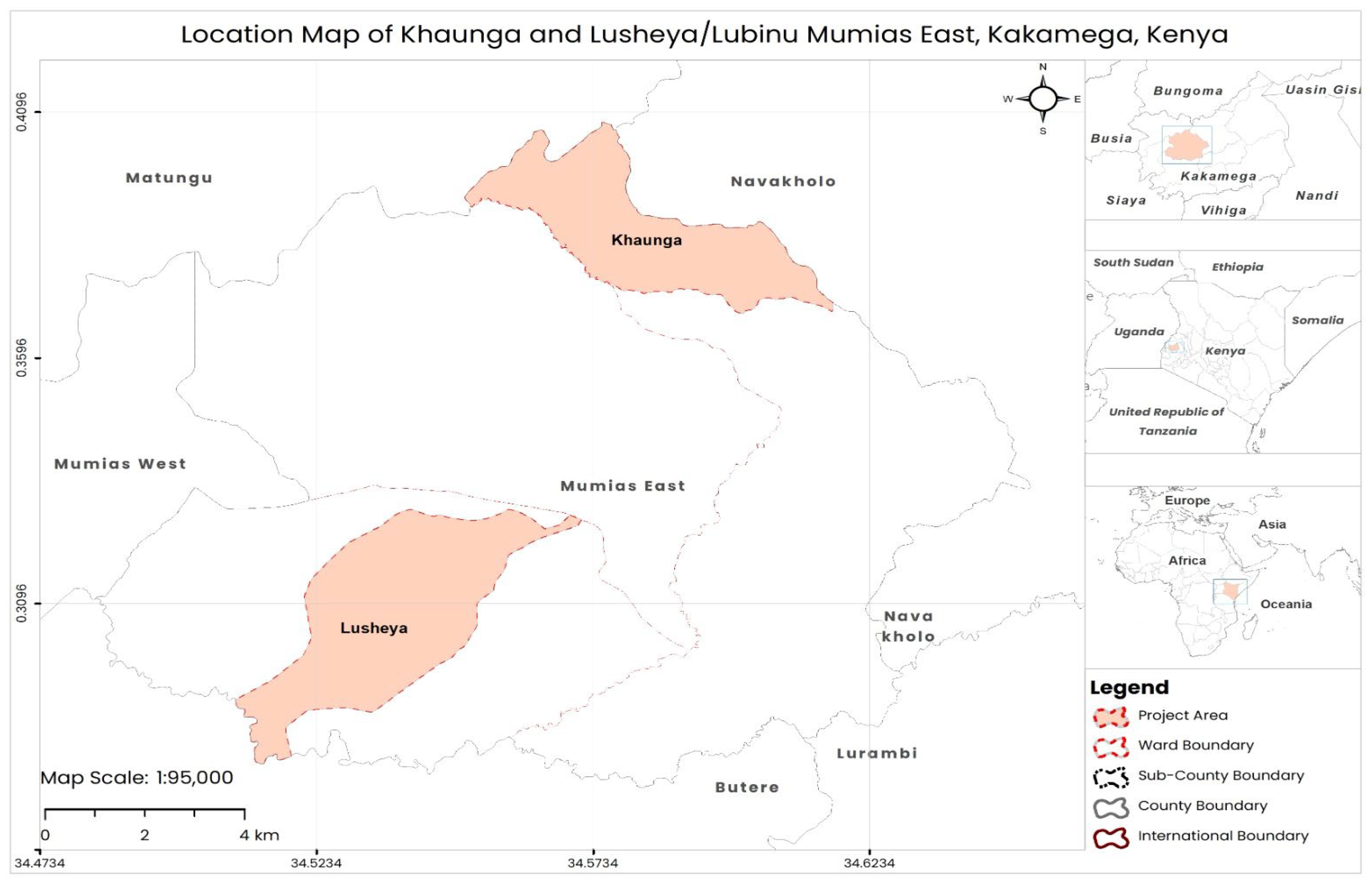
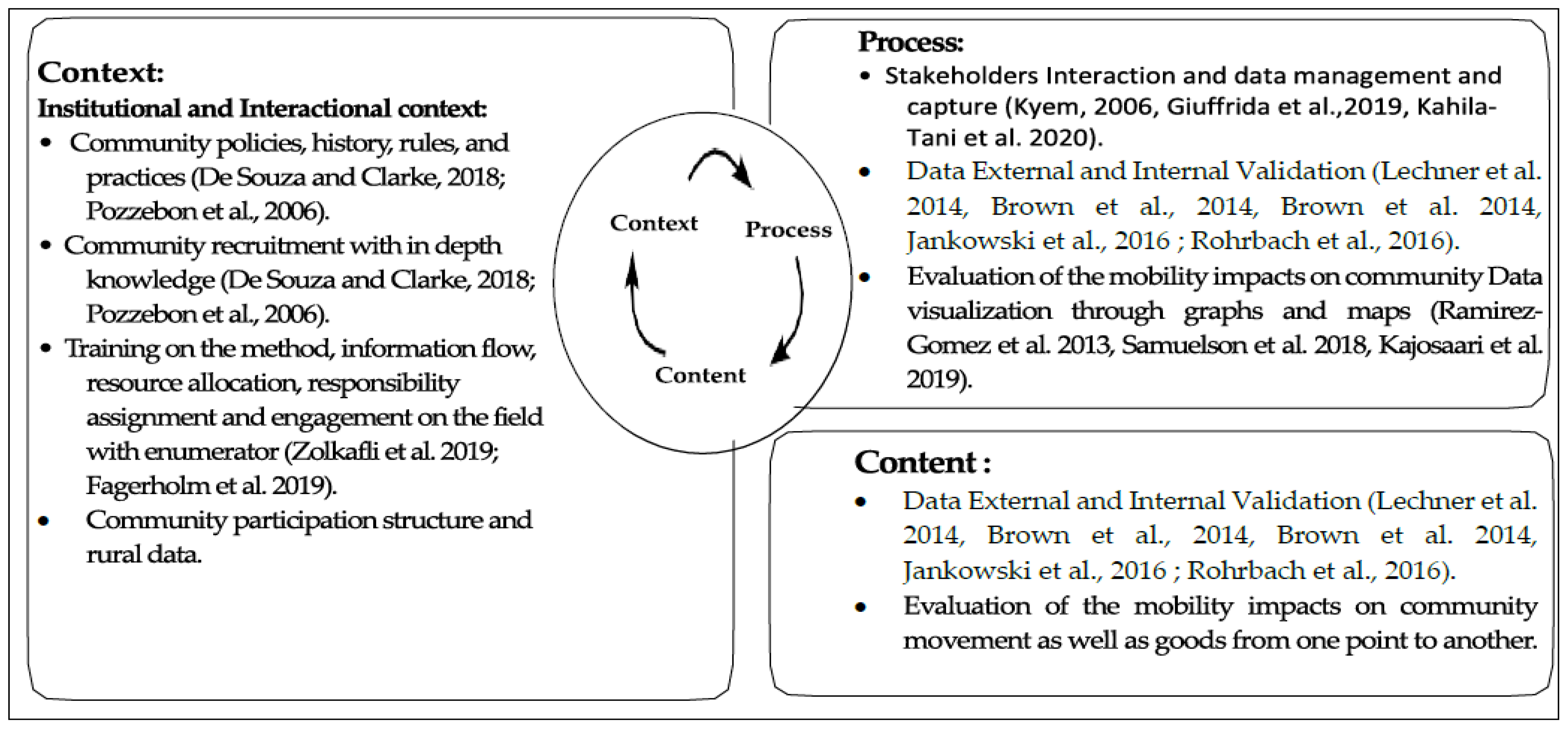
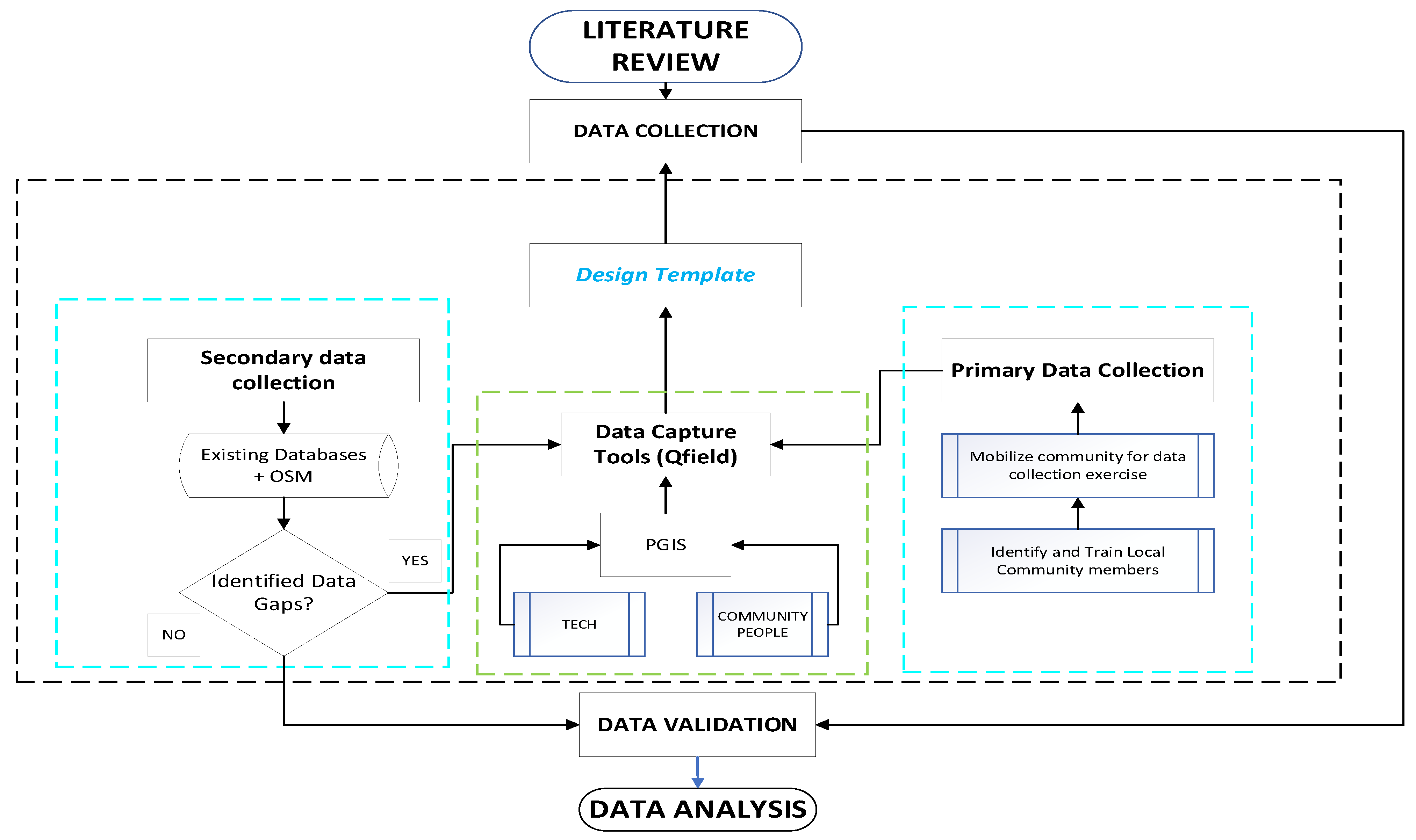

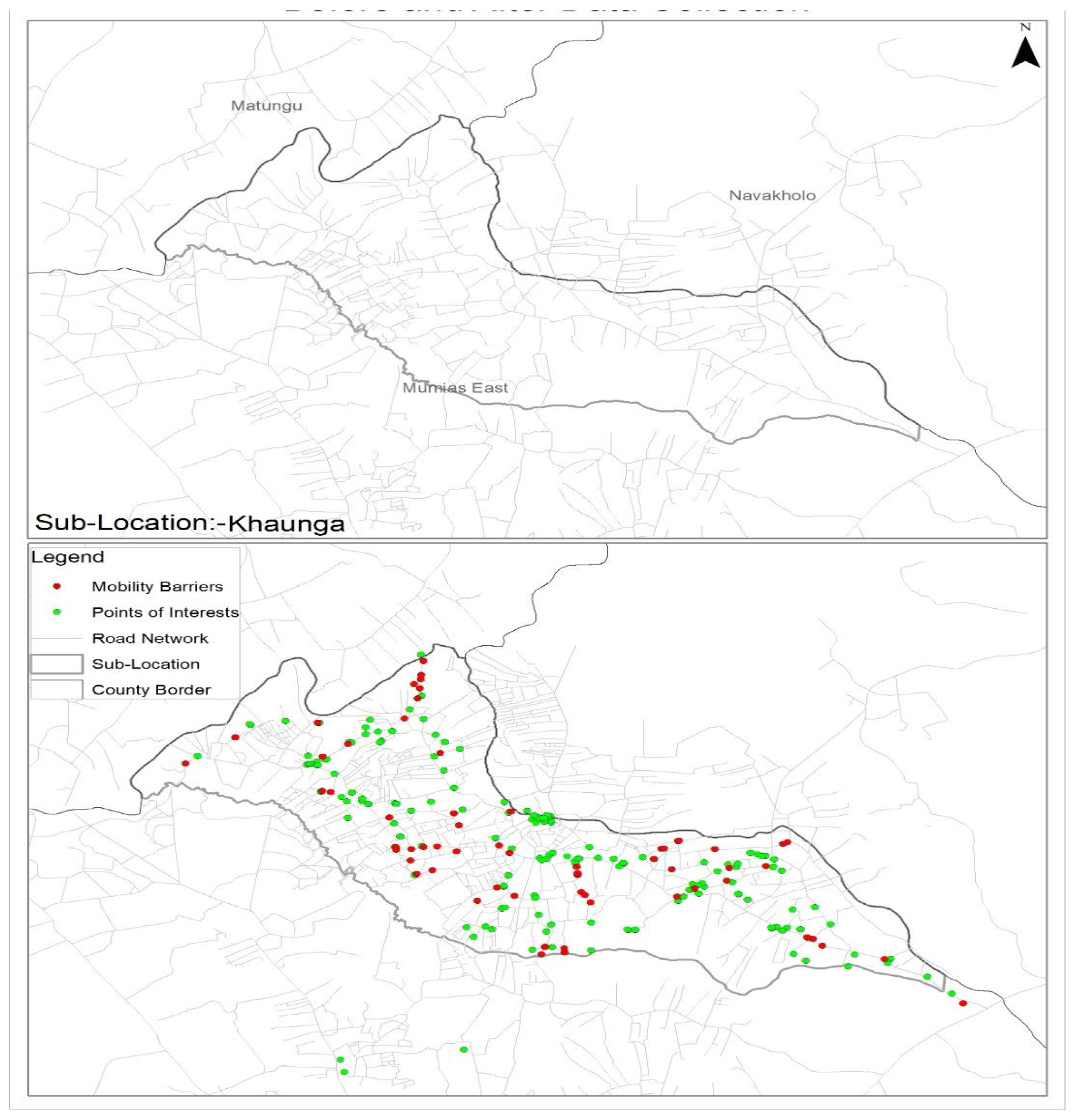
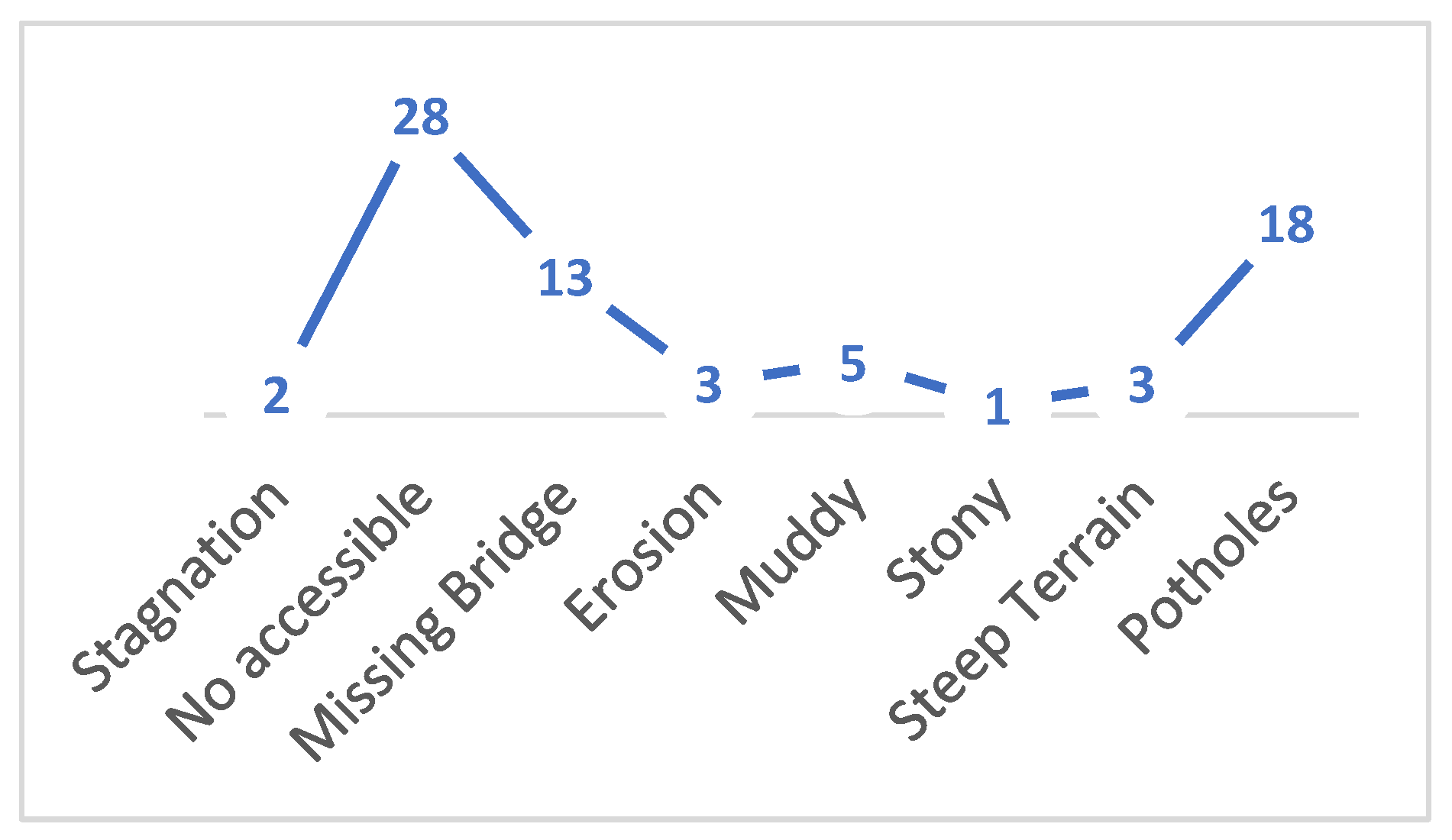
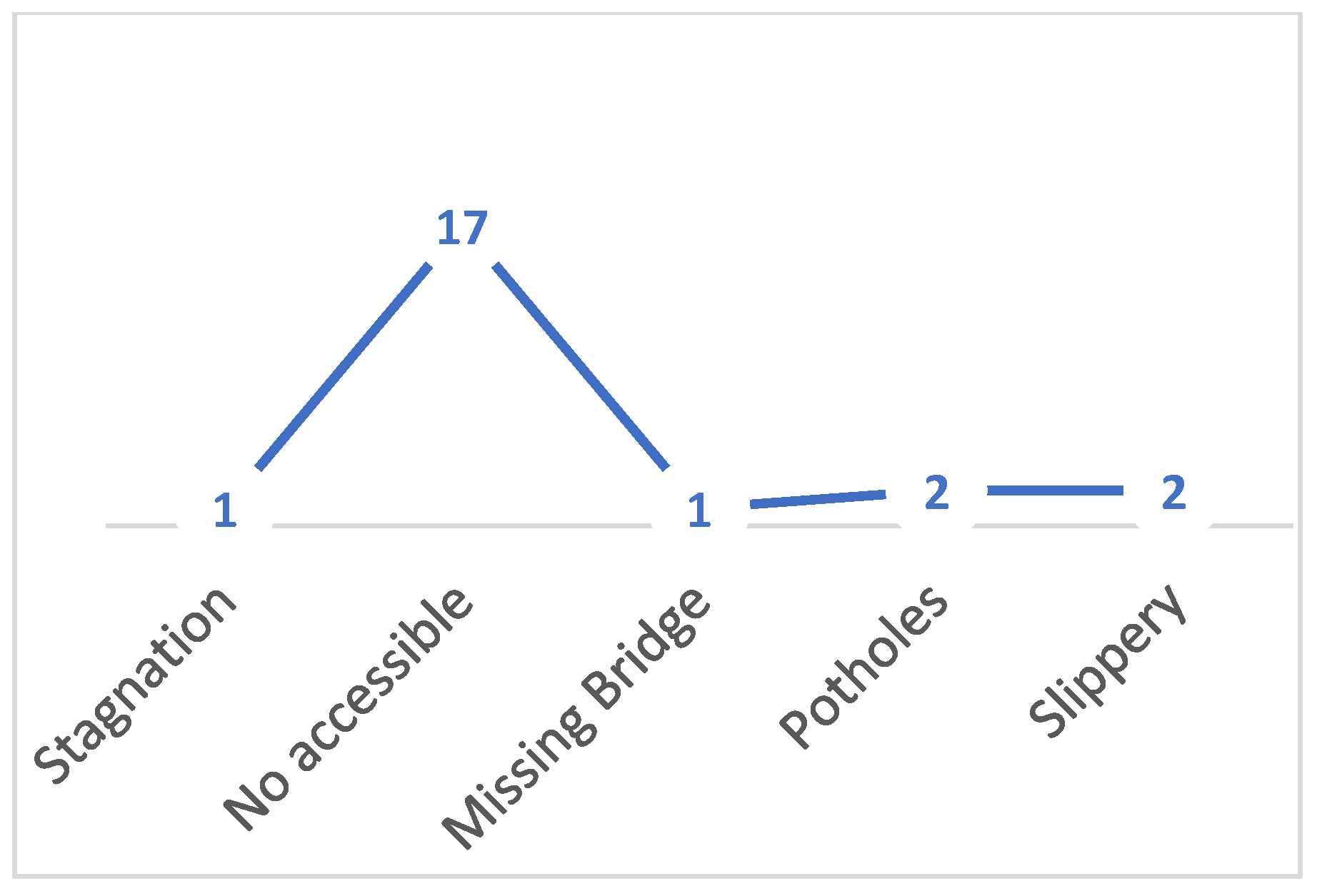
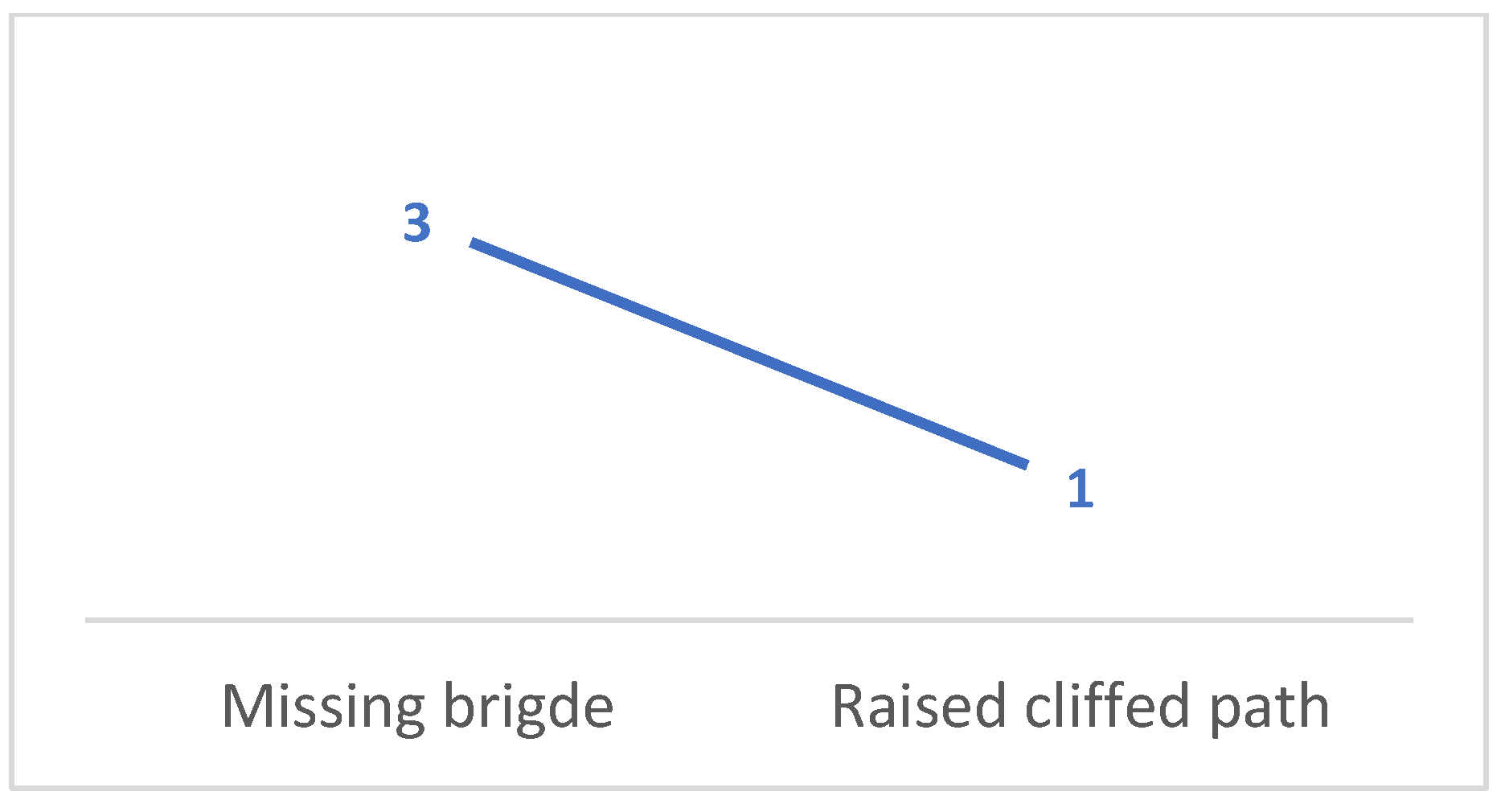

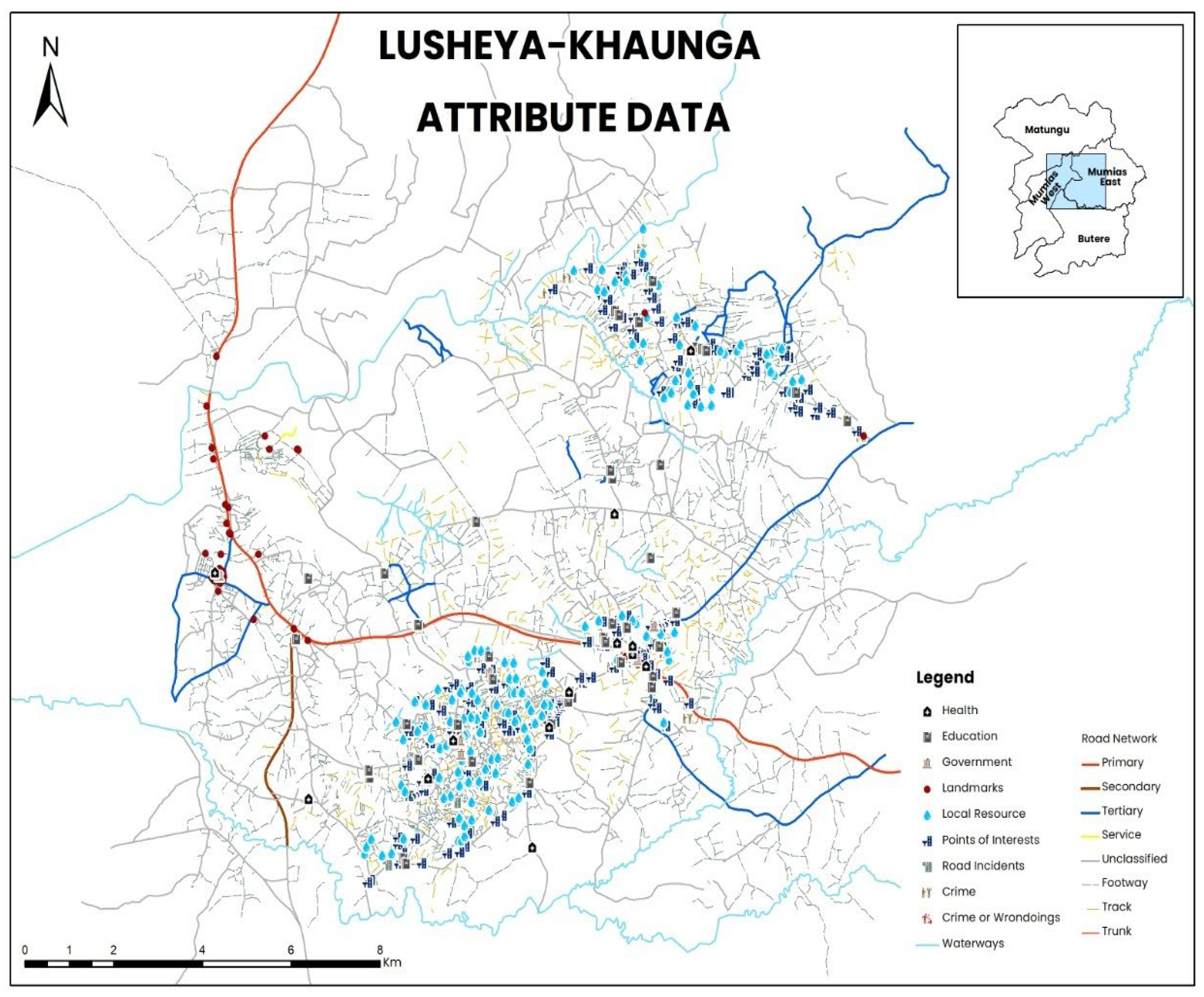
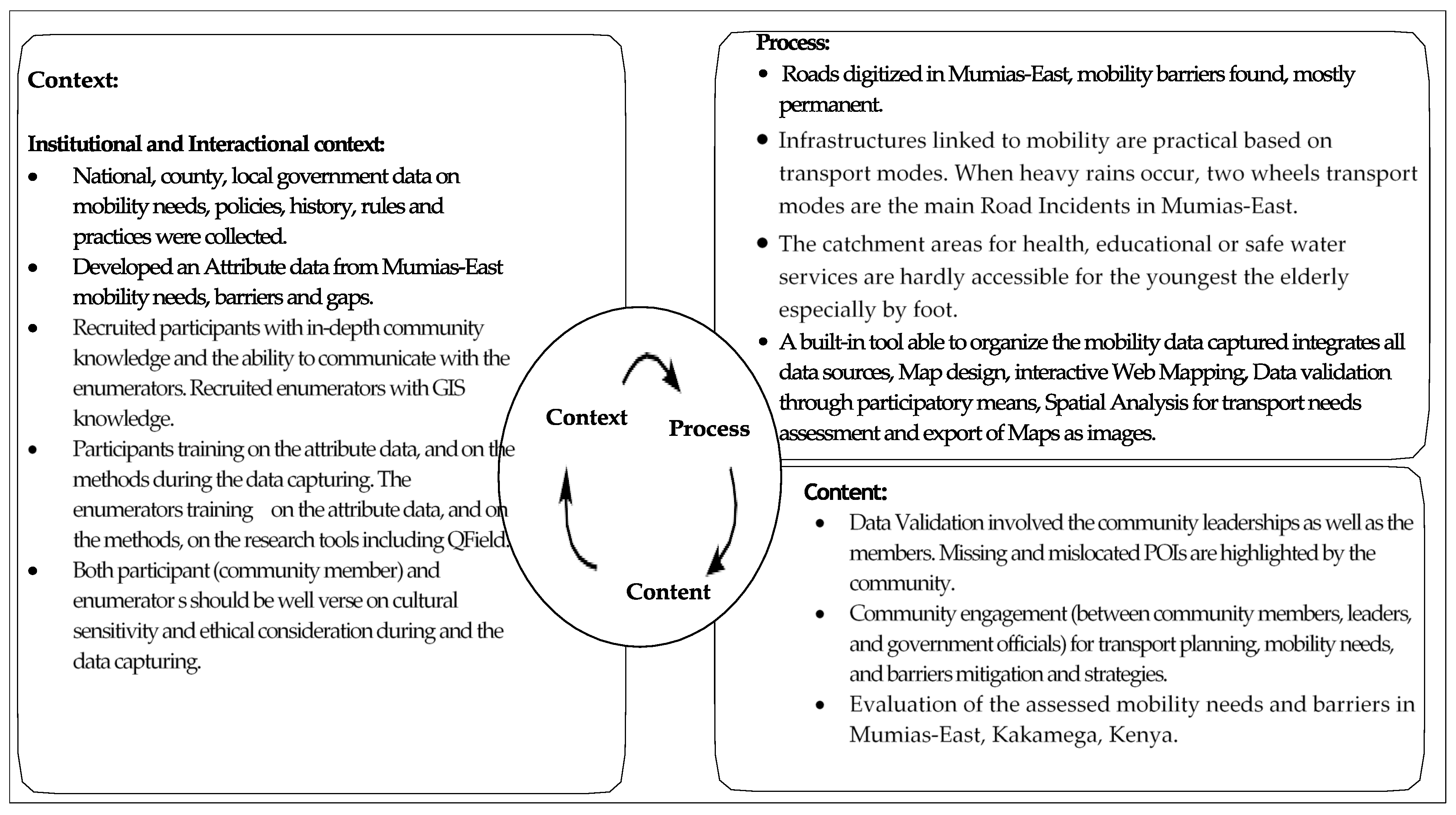
| Attribute | Categories | Description of Data Collected |
|---|---|---|
| Mobility barriers | Damaged infrastructure, waterlogged area, excessive traffic, open sewage, improper parking, unmaintained paving, unmanaged street vendors | Road networks, infrastructure barriers that could impede its accessibility. |
| Road Incidents | Road crash, animal attack, physical attack | Ensuring that the area collected or the POI did not have a road incidents history that could impede its accessibility. |
| Crime or Wrong doings | Harassments, theft, physical aggressions, substance abuse | Ensuring that the area collected or the POI did not have a crimes or wrongdoings history that could impede its accessibility. |
| Education | School, college/TVET, university, kindergarten | Location of the education facilities, its capacity, its accessibility by public transport, by bicycle, by car, and its population base. |
| Health | Pharmacy, clinic, health Center, hospital | Location of the health facilities, its capacity, its accessibility by public transport, by bicycle, by car, and its population base. |
| Government | Chief office, assistant to the chief, other government office | The chief and the government offices assisted by granting the team the authorization to conduct research and by providing secondary data and village leaders contacts as well as community members for training and data collection. |
| Points of Interest | Religious sites, local business, public spaces, security forces, hotels, lodges and restaurants, industries and factories, tourist sites, recreational centers, public toilets, fuel stations, transport utility shop, bicycle shop/repair, bank, money transfer, posho-mills | Locations that communities may find useful or interesting. |
| Street profile | Street profile, administrative border line, other | Street landmarks serving as a reference for road users and other community members. |
| Local Resource | Water | The research covered all sources of freshwater for human consumption, from boreholes to controlled water stream. |
| Road Network | Primary, residential, (primary link), secondary, service, unclassified, track, footway, path | The road link between two communities (streets, villages, sub-locations, locations, wards, sub-county, etc.) |
| Waterways | Rivers, streams | Linear water features, often used as border line (between two villages, sub-locations, locations, wards, sub-county or county) water sources for animals and farmers. |
| SN | Data Type | Source 1 | Source 2 | Source 3 |
|---|---|---|---|---|
| 1 | Health Facilities | OSM | Local Municipal Geodatabase | primary survey using Qfield |
| 2 | Education Facilities | OSM | Local Municipal Geodatabase | primary survey using Qfield |
| 3 | Local Boundaries | OSM | Local Municipal Geodatabase | primary survey using Qfield |
| 4 | Points of Interest (POI) | OSM | Local Municipal Geodatabase | primary survey using Qfield |
| 5 | Road Networks | OSM | Local Municipal Geodatabase | primary survey using Qfield |
| 6 | Crime or Wrongdoings | Local Municipal Geodatabase | primary survey using Qfield | |
| 7 | Road Incidents | Local Municipal Geodatabase | primary survey using Qfield | |
| 8 | Street profile | Local Municipal Geodatabase | primary survey using Qfield | |
| 9 | Local Resource | OSM | Local Municipal Geodatabase | primary survey using Qfield |
| 10 | Waterways | OSM | Local Municipal Geodatabase | primary survey using Qfield |
| Attributes | Context | Process | Content |
|---|---|---|---|
| Mobility barriers | Kenya Rural Roads Authority, Ministry of Roads and Transport and local governments | Mostly permanent and represented only 4% of the digitized roads. | Most digitized roads with barriers were practical by foot and bicycles in Lusheya sub-locations. Damaged infrastructures and waterlogged areas have the highest barrier causes. |
| Road Incidents | Kakamega Traffic Police Department, local authorities and road users. | Mostly caused by poor infrastructure, often from heavy rain. | Road crashes are the most occurring road incidents, particularly in Mahola. |
| Crime or Wrongdoings | Kakamega Police Department, local authorities and road users. | Theft in private property is the most common crime in Lusheya, followed by substance abuse and harassment. | Populated areas are the most exposed to thefts. Substance abuse and harassment also make it unsafe for road users, especially at night. |
| Education | Kakamega, Mumias East Department of Education and local authorities | Most education facilities are public. Not much available for reduced mobility students. | School catchment area is about a 6 km radius. Students’ daily travels amount between 450 and 1250 per school (mostly by foot) on paths and tracks. |
| Heath | Kakamega, Mumias East Department of Health and local authorities | Most health facilities are public. Most health centers and clinics are run by experienced nurses. Most health facilities have limited emergency services, out-of-hours services or even ICUs. | Health catchment facilities are about 3000 to 15,000 populations mostly during day time. Patients often use bicycles or motorcycles for critical cases. Foot travel is generally the standard transport mode. |
| Government | Local authorities, government buildings and chiefdom in Kakamega. | Most government offices data were collected in Khaunga. | Shianda is the administrative center for government offices as well as commercial activities in Khaunga location. |
| Points of Interest | Local authorities and participants | Most points of interest include local businesses and religious sites. Lusheya had the most points of interest. | Churches, shops, porsho mills and brick-laying businesses are the most common points of interest in the three sub-locations visited in Mumias East. |
| Local Resource | Local authorities and participants | Most local resources in Mumias East are boreholes and springs. Paths and tracks mainly connect residents and farms to rivers and streams. Transport modes include foot, bicycle, and animals in remote places. | The location of boreholes (commonly shared with the community), springs, rivers and water points impact mobility. |
| Road Network | OSM, Ministry of Roads and Transport, enumerators, local authorities and participants | Most road networks collected are residential, tracks and paths. Mahola has the most road networks digitized, with residential and tracks being the two highest. Khaunga has the highest amount of paths. | Most road networks are accessible to at least one transportation mode. |
| Waterways | Local authorities and participants | Most waterways are rivers and streams. Rivers and streams are often crossed by bridges on paths and tracks connecting one point to another. | Both a cause (livestock, agriculture and plants) and a barrier (missing bridges) to mobility. Infrastructure damage is another consequence. |
Disclaimer/Publisher’s Note: The statements, opinions and data contained in all publications are solely those of the individual author(s) and contributor(s) and not of MDPI and/or the editor(s). MDPI and/or the editor(s) disclaim responsibility for any injury to people or property resulting from any ideas, methods, instructions or products referred to in the content. |
© 2023 by the authors. Licensee MDPI, Basel, Switzerland. This article is an open access article distributed under the terms and conditions of the Creative Commons Attribution (CC BY) license (https://creativecommons.org/licenses/by/4.0/).
Share and Cite
Munyaka, J.-C.B.; Chenal, J.; de Roulet, P.T.H.; Mandal, A.K.; Pudasaini, U.; Otieno, N.O. Multi-Level Participatory GIS Framework to Assess Mobility Needs and Transport Barriers in Rural Areas: A Case Study of Rural Mumias East, a Sub-County of Kakamega, Kenya. Sustainability 2023, 15, 9344. https://doi.org/10.3390/su15129344
Munyaka J-CB, Chenal J, de Roulet PTH, Mandal AK, Pudasaini U, Otieno NO. Multi-Level Participatory GIS Framework to Assess Mobility Needs and Transport Barriers in Rural Areas: A Case Study of Rural Mumias East, a Sub-County of Kakamega, Kenya. Sustainability. 2023; 15(12):9344. https://doi.org/10.3390/su15129344
Chicago/Turabian StyleMunyaka, Jean-Claude Baraka, Jérôme Chenal, Pablo Txomin Harpo de Roulet, Anil Kumar Mandal, Uttam Pudasaini, and Nixon Ouku Otieno. 2023. "Multi-Level Participatory GIS Framework to Assess Mobility Needs and Transport Barriers in Rural Areas: A Case Study of Rural Mumias East, a Sub-County of Kakamega, Kenya" Sustainability 15, no. 12: 9344. https://doi.org/10.3390/su15129344
APA StyleMunyaka, J.-C. B., Chenal, J., de Roulet, P. T. H., Mandal, A. K., Pudasaini, U., & Otieno, N. O. (2023). Multi-Level Participatory GIS Framework to Assess Mobility Needs and Transport Barriers in Rural Areas: A Case Study of Rural Mumias East, a Sub-County of Kakamega, Kenya. Sustainability, 15(12), 9344. https://doi.org/10.3390/su15129344







